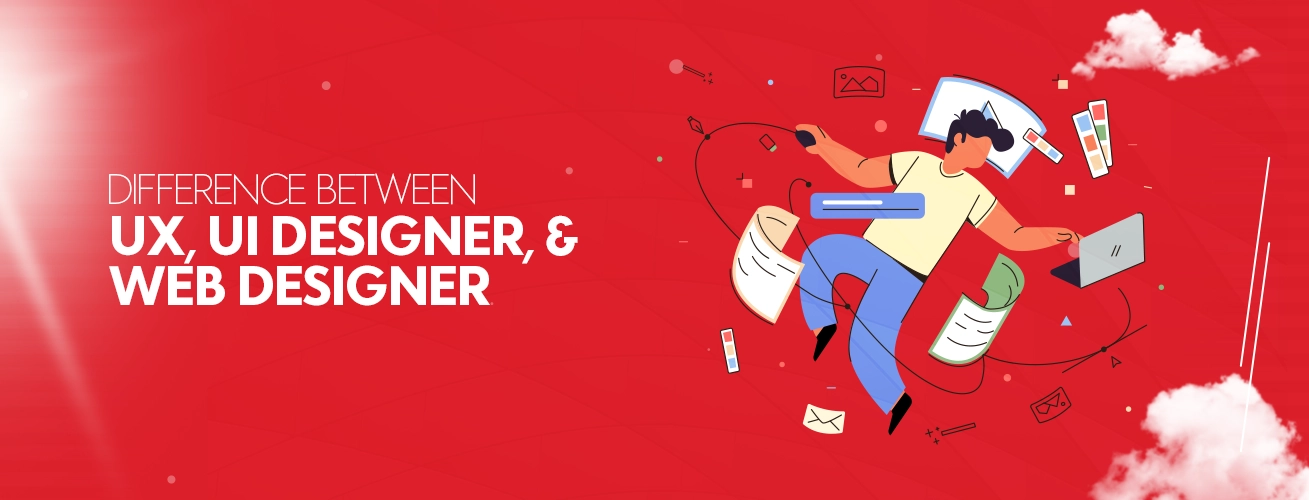Difference between UX, UI Designer, and Web Designer
The world of digital design has seen explosive growth in recent years. This meteoric rise in this industry has proliferated many puzzling words, acronyms, and abbreviations. UI Design, UX design, and Web design are some of the many words that layman finds harder to understand. Online business managers stepping into the digital world struggle to know whether there is any difference among them or whether their differences really matter. Business owners also want to know which one should be preferred and which area should be given less priority when finalizing an IT firm offering UX, UI, and web design services.
In this article, we are going to solve these puzzles. We will describe all these terms comprehensively and will let you know how related they are in the dynamic world of digital design. To further illustrate the points, this blog will provide you with real-life examples to demystify the different roles web, UI, and UX designers are offering in the online landscape.
Ready are you ready? Let’s get the ball rolling!
Let’s start with UX and UI design first.
Defining User Experience (UX) Design:
Strictly speaking, user experience design, or UX, is not an exclusive term for digital design. It can be applied to every kind of product, but nowadays, its use in digital design is restricted. The aim of every UX design firm is to create a digital product that is user-friendly, intuitive, easy, and enjoyable for people to use. Every UX design expert works hard to optimize the interactions between a user and the digital product which can be a mobile application, a web application, or a website.
An expertly built UX design makes sure that the interaction between user-computer is smooth and intuitive. It also determines how a user feels while navigating the digital product. Overall, a UX expert has expertise in working with the structure and functionality of user Interface. They make sure that human-computer interaction remains seamless with the optimum organization of these elements of the User Interface.
In short, the UX team focuses on the following elements of digital products:
- User-Interface interaction
- Navigation
- Consistency
- User satisfaction
- Structure
What Kinds of Projects UX Designers Focus On:
UX designing is an extensive field, covering very diverse areas which play a key role in the success of any online business. Here are some areas where UX designers work:
1-Website and App, and Software Design:
In this age of a digital-first business environment, the usability of a website, app, or piece of software is what determines its success. UX designers are given the responsibility to ensure that users enjoy e seamless and smooth user experience with a digital product.
Be it an eCommerce store, mobile application, CRM software, or web application, each of every digital product is the result of the sweat and toil of a UX expert.
2- Service Design:
UX designs are not restricted to tangible products only, they also create or improve the experience as well. They design services in a way to makes them enjoyable and engaging.
3-Voice Design:
Voice user interfaces are on a meteoric rise. More than 50% of adults in the USA are using voice searches for various queries on search engines. UX designers have a huge role in this field as well. They design websites and applications in a way to makes them friendly to voice searches.
4- Augmented Reality (AR) and Virtual Reality (VR):
The global VR market is fast growing and evolving. Many marketers are employing these technologies in their marketing campaigns and other ends. UX designers have a key role in incorporating AR and VR in various end products to offer users immersive and deeply engaging experiences. IT firms are asking their UX experts to adapt these technologies to drive more interactions with their customers.
Now we look at some critical elements of a successful UX design process.
Wireframing and Prototyping in UX Design:
Wireframing and prototyping are essential components of the UX design process. They have a unique role to play in product development.
Role of Wireframing in User Experience Design:
Wireframing is a process in which a skeleton or blueprint of a digital product is created. Designers draw simply the overviews of products so that they can determine the structure and flow of possible design solutions.
These outlines mirror the users’ needs and preferences. Wireframing involves various phases such as:
- Understanding the goals and objectives of a product
- Sketching ideas to have a broader understanding
- Drawing of low-fidelity wireframes.
- Refining and reiteration the wireframes
- High-fidelity wireframes
- Testing and validation
- Finalizing the UX design project
Given the fact that wireframing has an indispensable role in the UX design process, you can rightly assume that it is a building block of a successful project. Expertly accomplished wireframing allows you to avoid mistakes and deliver a smooth and seamless User Experience.
Role of Prototyping in the UX Design Process:
Prototyping is another major pillar of UX design development. In the UX design process, prototyping is a preliminary model of some products from other iterations that are copied and developed. Prototyping is in fact done to show design intent that shows to developers and stakeholders how users would interact with the final products.
Prototyping has also an important role to play in UX design plans. It could be done either for a whole app or with a singular iteration. It plays a significant role in product development in the following ways:
Since prototyping is performed during the research phase, it allows developers to test the product before final development. Developers can know whether their intended design would work or not. IT firms can thus save both time and resources.
Secondly, the feedback gathered helps developers to resolve the issue before the final product is launched. You can maximize usability based on the feedback from feedback.
Before we move to our next topic- User Interface-, it should be pointed to note that an expert UX designer must be sensitive enough to fully grasp the target audience’s needs and preferences. Therefore, empathy has a critical and beneficial role in well-informed design. But why should you need empathy, an emotion, in a world of cold tech world? let’s get the answer.
How Can UX Designers Build Empathy into Their Projects?
Empathy can be understood as the ability to understand and share expectations, needs, preferences, values, and norms. In the world of graphic design, building empathy is important because it helps developers to better understand the goals of projects.
An empathetic UX designer is capable of experiencing the target audience’s needs and pain points not from a distance, but from live experience. Therefore, empathy plays a role throughout the project development process. In particular, at the design thinking step in the UX graphic framework, empathy is given serious consideration. The design thinking process starts with empathizing, and then other stages such as defining, ideating, prototyping, and testing are pursued systematically.
These are ways in which empathy can be incorporated into the UX design framework:
First, you start with an understanding of the design problems
Second, learning about the target audience and their points should be given a considerable amount of time and resources.
Third, immersing yourself in the user experience as much as possible would also give you a tool to empathize with end users of projects.
Fourth, detaching from user experience and thinking like a designer is also considered a good way to better incorporate that experience to offer seamless UX.
Finally, incorporating feedback and inculcating a learning attitude are also some ways to build an empathetic UX design that reflects the target audience’s needs and preferences.
In short, UX has a very fundamental role to play, but we should understand that a feature-rich and user-friendly digital product also demands other ingredients as well. UI or User Interface is one of them. Let’s comprehensively discuss this concept.
Defining User Interface (UI) Design:
Unlike User Experience which determines how users interact with digital products, User Interface is mainly concerned with the look, feel, and presentation of a product. It is a strictly digital term that deals with how the visual representation of an application or website would look.
The user interface is the point of contact between the user and the device or product. For instance, the touchscreen on your mobile phone and various icons, buttons, and other stuff that appear on an app or website all come under User Interface (UI).
Succinctly speaking, a User Interface Design includes everything when you use a digital product. Normally, a User Interface Designers take care of the following elements of visual representation:
- Screen layout
- Icons and buttons
- Topography
- Images
- Spacing
- Interface animation
- Among others
User user interface is all about visuals. Therefore, understanding visual hierarchy in UI is critical to better understanding this concept.
Importance Of Visual Hierarchy in User Interface Or UI:
In User Interface design, visual hierarchy is a fundamental ingredient. Visual hierarchy means arranging various elements of design to show their relative importance. It plays a crucial role because laying out various visual elements strategically helps gain the attraction of viewers and nudges them to perform the desired tasks such as subscribing to newsletters etc.
Visual hierarchy has various building blocks that UX experts deploy as their strategy to make the visual representation of digital products appealing and attractive. Some elements are discussed below briefly:
Color: the brighter the color, the more attraction they receive from the target audience.
Contrast: If the colors are dramatically contrasted, they are more eye-catching.
Proximity: If two visual elements are closely placed, they seem related to each other.
Repetition: the repetition of styles implies that content is closely related.
Whitespace: The more whitespace around the elements, the more eye-catching.
Texture & Style: If the texture is richer, it easily stands out from the flat ones.
UI is a comprehensive field that warrants an in-depth understanding and expertise. Apart from visual hierarchy, expert UX designers need to fully practice UI principles. We have discussed them as well to give you a better conceptualization of UI terms.
User Interface (UI) Design Principles:
Here are UI Design principles you should know:
- Hierarchy
- Progressive Disclosure
- Consistency
- Contrast
- Proximity
Now discuss them one by one briefly.
1-Hierarchy:
Hierarchy is concerned with ordering colors, text, and style in a way to attracts eyes to the most critical elements of UI. It aims at helping viewers recognize the most important information and giving less attention to those elements that are not so important vis-à-vis marketing.
2- Progressive Disclosure:
This principle guides the developers to reveal only the information that is requested. In other words, UI experts prioritize what to include in the user interface and what to exclude at the right to reduce cognitive loads. Too many features can sometimes overwhelm the users because they have to make a lot of decisions at a time. Therefore, the UI design process is made user-centric by only necessary or required information.
3-Consistency:
This is another important UI design principle. UI experts make sure that there are common UI elements and behaviors throughout the interface. They make digital products easy to navigate with recognizable signposts and predictable controls, allowing users to take charge of their experience. Consistency is thus a key factor in helping you provide a better user experience.
4- Contrast:
The contrast in color, size, shape, and style helps developers to underline important elements of UI. For instance, for critical pieces of information like warnings or deleting the account, developers use the contrast principle, giving sharp color to these warnings to make them stand out.
5-Promixity:
This principle says that the more your elements are placed closer in visual design, the closer the associations they show. Designers align all closely related elements in UI, for instance, in live-streaming services, all related features, such as fast-forward, rewind, and play buttons, are placed in a row. This increases usability and enhances the user experience as well.
Having discussed UX and UI in-depth, it would be appropriate to know how important they are in the overall grand scheme of events.
How Important Are UI/ UX Design in Product Development:
Both UI and UX designs play an incredibly important role in the development of various digital products. Understanding differences can help you give due priority to these vital elements of the mobile app or web app development process.
Here are some ways in which UI/UX plays a key determinant role in the successful execution of web or mobile app projects.
1-Improved User Interactions:
Since both UX and UI aim to deliver seamless and meaningful human-computer interactions, they end up in enhanced user interactions. A well-designed UI/UX ensures a delightful user experience, leading to better engagement, and by extension, fostering a positive perception about the product.
2- Better User Retention:
Compelling UX and UI designs also play a key role in improving user retention rates. UX and UI ensure an intuitive interface and seamless interactions. You can thus force your visitor to spend more time within the application or on your website, allowing you to reduce the bounce rate and enhance user retention rate.
3- Promotion of Brand Identity:
UI in particular, reflects the brand values and messaging. You can thus hire an experienced UX/UI designer firm to mirror your brand. This helps you create a visual appeal that better serves your marketing goals because your products would then be recognizable instantly.
4- Enhanced Usability:
The better useability of your product is another major benefit of employing a better UX/UI design. A User-friendly interface, intuitive workflow, and clear navigations help your visitors accomplish tasks easily and efficiently.
5- Reduce Development Costs:
A well-designed User Interface means that you can avoid problems that usually rack up development costs. On top of that, you can also avoid customer queries because user-friendly interface, allowing you to better utilize the resources and time of your workflow for other productive tasks.
Now that we have dealt in great depth with the differences between UX and UI, it should be noted that both work in close partnership. In an IT firm, UX and UI experts are found to complement each other to come up with a product that has visual appeal and optimum user experience.
Let’s see how UX and UI work together.
The Relationship Between UX and UI Designs:
While reading differences between UX and UI design, you may end up wondering if these are opposite. This is not the case. Both are vital for each other. You can consider UX as a cake and UI as an icing on the cake. They work hand in hand and there are millions of examples where good UX and UI complement each other to produce stunning digital products and services.
In a grand scheme of product development, UX helps establish the ground for a good user experience and UI adds to user experience by making the product intuitive and attractive. The job of UX designers is to create a structure of a product, UI designers take that structure, enhance its visual appeal, and give it a makeover so that it looks nicer to the eyes. Together they create a product that is aesthetically appealing functionally seamless and easy to use.
These are reasons why IT firms are often advertising UX and UX roles. Both experts have very key role in the design process. This understanding now brings us to the next section: what is the design process and what roles do UX and UI experts in it?
Steps Involved in UX/UI Design Process:
The design process in product development is a series of steps that UX and UI take to convert an idea into a product with a fully functional and user-friendly interface. Here are some steps that every UX/UI expert goes through.
#01: UX Research:
In this step, UX experts conduct extensive research about the target audience, competitors, and product. There are many ways research can be conducted, but usually, UX/UI designers carry out some specific steps. For instance, establishing a timeline, conducting user interviews, drawing empathy maps, identifying users’ pain points, creating personas, drawing user journey maps, making problem statements, and performing competitors are some steps involved in the UX research step.
#02: Define and Ideation:
In this step, readymade UI/UI design templates are used to define what the target audience needs and what competitors are offering to the market. In addition, UX/UI uses various platforms such as FIGMA to generate maximum ideas. After defining needs and ideation, UX/UI experts undertake the next step which is information architecture.
#03: Information Architecture:
In this step, experts use Information Architecture principles to organize and structure the information and ideas gathered so far. In this regard, sitemap and user flow play a critical role in the design process. There are many ways to create User Flow and Sitemaps, Wireflow kit is one of the best way to accomplish this task.
#04: Wireframing:
Wireframing is an important step. As it has early been discussed above, it is a 2D visualization of a digital product. It can be very basic such as pencil sketch or it can be very advanced such as fully interactive digital designs.
Experts divide wireframing into low-fidelity, medium-fidelity, and high-fidelity depending on the level of sophistication.
#05: Prototyping:
This is an important step in the UX/UI design process. In this step, UX/UI designers convert high-fidelity wireframes into highly interactive demonstrations. These demonstrations resemble the real products in design and they are used for user testing and gathering user feedback.
#06: Design Systems:
Creating a design system is also an important step. It is a collection of various design elements such as buttons, forms, and the like. Design systems a pre-designed and they help UX and UI designers and builders create User Interfaces more effectively.
#07: Mockup:
In the mockup, designers take high-fidelity wireframes and add content, styles, and branding. Mockups help designers and builders gather feedback from users and iterate on their mockup designs.
#08: User Test:
In this step, high-fidelity prototypes are deployed to get feedback. Experts conduct various usability tests with different groups of users to create user stories. The main objective of conducting user tests is to determine whether a solution works for users or not.
#09: Go Live:
Now, it is time to launch the final product. Though UX/UI is an ongoing process. It is always in need of maintenance and fixing some visual elements. You should not worry about them.
UX and UI are important, there is no denying it. You have now some understandings, but one question remains: are there some real-life examples that show that UX and UI can lead to success in this overcrowded online marketplace? The answer is yes. There are some examples.
Real-Life Examples Showing Successful UX/UI Designs:
Here are some important case studies that show how impactful it can be to have well-crafted UX/UI designs for your digital products:
-
Netflix and Uber Eats:
These companies have utilized successfully user-centric UX/UI designs, allowing them to gain a competitive edge in the market.
-
Hotjar:
This firm is another success story that shows how an effective design thinking process can lead to a tool for problem-solving for investors and other stakeholders.
These are two online companies that have worked wonders through having well-researched and executed UX/UI designs. But these separate but closely related fields are fast evolving. Many trends in 2024 are transforming them most dramatically. Let’s discuss them briefly.
Future Trends to Look In 2024 And Beyond In UX/UI Designs:
No doubt, the world of UX/UI is changing deeply. Here are some trends that you should keep in mind for learning UX/UI skills.
A- Immersive AR/VR Experience:
UX/UI designers have started to use AR/VR technologies to deliver conversational interfaces and immersive and interactive user experiences.
B- Interactive Animations:
This is another trend that is taking UX/UI to another level. Experts are coming up with interactive animations in design that deliver responsive, dynamic, engaging, and intuitive user experience.
C- Resurrection of Topography:
Once again in 2024, topography is becoming a preferred choice for branding and design expression. It has become a fundamental element of visual design all over the world.
D- Accessible Design:
UX/UI focuses on delivering a user experience that is accessible to everyone. Now that digital platforms are no longer confined to typical hardware such as mobile phones or laptops, accessible design has become a top priority because it allows people with disabilities to enjoy barrier-free digital experiences.
Final Thoughts:
There is no denying that UX/UI design has become a central pillar of any successful digital product. Their role is transforming, but their importance is all obvious. They determine the usability of any digital products. In line with their critical importance, we have written this blog to help you understand the fundamentals of UX and UI design and their differences. If you are a firm that is hiring an IT agency offering UX/UI services or you are an IT professional looking for a job in a software house, you must understand their differences. Having said that, the trends that are transforming the UX/UI fields indicate that all IT experts must continue learning and adapting to new and emerging technologies such as AI, AR/VR, animations, and more.
We do hope you have found this article informative. We are looking forward to receiving your feedback to further improve our contributions.




